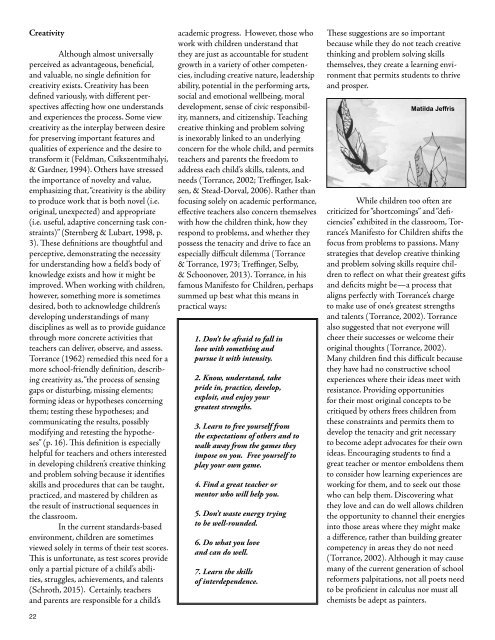Torrance Journal for Applied Creativity
TorranceJournal_V1
TorranceJournal_V1
You also want an ePaper? Increase the reach of your titles
YUMPU automatically turns print PDFs into web optimized ePapers that Google loves.
<strong>Creativity</strong><br />
Although almost universally<br />
perceived as advantageous, beneficial,<br />
and valuable, no single definition <strong>for</strong><br />
creativity exists. <strong>Creativity</strong> has been<br />
defined variously, with different perspectives<br />
affecting how one understands<br />
and experiences the process. Some view<br />
creativity as the interplay between desire<br />
<strong>for</strong> preserving important features and<br />
qualities of experience and the desire to<br />
trans<strong>for</strong>m it (Feldman, Csikszentmihalyi,<br />
& Gardner, 1994). Others have stressed<br />
the importance of novelty and value,<br />
emphasizing that, “creativity is the ability<br />
to produce work that is both novel (i.e.<br />
original, unexpected) and appropriate<br />
(i.e. useful, adaptive concerning task constraints)”<br />
(Sternberg & Lubart, 1998, p.<br />
3). These definitions are thoughtful and<br />
perceptive, demonstrating the necessity<br />
<strong>for</strong> understanding how a field’s body of<br />
knowledge exists and how it might be<br />
improved. When working with children,<br />
however, something more is sometimes<br />
desired, both to acknowledge children’s<br />
developing understandings of many<br />
disciplines as well as to provide guidance<br />
through more concrete activities that<br />
teachers can deliver, observe, and assess.<br />
<strong>Torrance</strong> (1962) remedied this need <strong>for</strong> a<br />
more school-friendly definition, describing<br />
creativity as, “the process of sensing<br />
gaps or disturbing, missing elements;<br />
<strong>for</strong>ming ideas or hypotheses concerning<br />
them; testing these hypotheses; and<br />
communicating the results, possibly<br />
modifying and retesting the hypotheses”<br />
(p. 16). This definition is especially<br />
helpful <strong>for</strong> teachers and others interested<br />
in developing children’s creative thinking<br />
and problem solving because it identifies<br />
skills and procedures that can be taught,<br />
practiced, and mastered by children as<br />
the result of instructional sequences in<br />
the classroom.<br />
In the current standards-based<br />
environment, children are sometimes<br />
viewed solely in terms of their test scores.<br />
This is un<strong>for</strong>tunate, as test scores provide<br />
only a partial picture of a child’s abilities,<br />
struggles, achievements, and talents<br />
(Schroth, 2015). Certainly, teachers<br />
and parents are responsible <strong>for</strong> a child’s<br />
22<br />
academic progress. However, those who<br />
work with children understand that<br />
they are just as accountable <strong>for</strong> student<br />
growth in a variety of other competencies,<br />
including creative nature, leadership<br />
ability, potential in the per<strong>for</strong>ming arts,<br />
social and emotional wellbeing, moral<br />
development, sense of civic responsibility,<br />
manners, and citizenship. Teaching<br />
creative thinking and problem solving<br />
is inexorably linked to an underlying<br />
concern <strong>for</strong> the whole child, and permits<br />
teachers and parents the freedom to<br />
address each child’s skills, talents, and<br />
needs (<strong>Torrance</strong>, 2002; Treffinger, Isaksen,<br />
& Stead-Dorval, 2006). Rather than<br />
focusing solely on academic per<strong>for</strong>mance,<br />
effective teachers also concern themselves<br />
with how the children think, how they<br />
respond to problems, and whether they<br />
possess the tenacity and drive to face an<br />
especially difficult dilemma (<strong>Torrance</strong><br />
& <strong>Torrance</strong>, 1973; Treffinger, Selby,<br />
& Schoonover, 2013). <strong>Torrance</strong>, in his<br />
famous Manifesto <strong>for</strong> Children, perhaps<br />
summed up best what this means in<br />
practical ways:<br />
1. Don’t be afraid to fall in<br />
love with something and<br />
pursue it with intensity.<br />
2. Know, understand, take<br />
pride in, practice, develop,<br />
exploit, and enjoy your<br />
greatest strengths.<br />
3. Learn to free yourself from<br />
the expectations of others and to<br />
walk away from the games they<br />
impose on you. Free yourself to<br />
play your own game.<br />
4. Find a great teacher or<br />
mentor who will help you.<br />
5. Don’t waste energy trying<br />
to be well-rounded.<br />
6. Do what you love<br />
and can do well.<br />
7. Learn the skills<br />
of interdependence.<br />
These suggestions are so important<br />
because while they do not teach creative<br />
thinking and problem solving skills<br />
themselves, they create a learning environment<br />
that permits students to thrive<br />
and prosper.<br />
Matilda Jeffris<br />
While children too often are<br />
criticized <strong>for</strong> “shortcomings” and “deficiencies”<br />
exhibited in the classroom, <strong>Torrance</strong>’s<br />
Manifesto <strong>for</strong> Children shifts the<br />
focus from problems to passions. Many<br />
strategies that develop creative thinking<br />
and problem solving skills require children<br />
to reflect on what their greatest gifts<br />
and deficits might be—a process that<br />
aligns perfectly with <strong>Torrance</strong>’s charge<br />
to make use of one’s greatest strengths<br />
and talents (<strong>Torrance</strong>, 2002). <strong>Torrance</strong><br />
also suggested that not everyone will<br />
cheer their successes or welcome their<br />
original thoughts (<strong>Torrance</strong>, 2002).<br />
Many children find this difficult because<br />
they have had no constructive school<br />
experiences where their ideas meet with<br />
resistance. Providing opportunities<br />
<strong>for</strong> their most original concepts to be<br />
critiqued by others frees children from<br />
these constraints and permits them to<br />
develop the tenacity and grit necessary<br />
to become adept advocates <strong>for</strong> their own<br />
ideas. Encouraging students to find a<br />
great teacher or mentor emboldens them<br />
to consider how learning experiences are<br />
working <strong>for</strong> them, and to seek out those<br />
who can help them. Discovering what<br />
they love and can do well allows children<br />
the opportunity to channel their energies<br />
into those areas where they might make<br />
a difference, rather than building greater<br />
competency in areas they do not need<br />
(<strong>Torrance</strong>, 2002). Although it may cause<br />
many of the current generation of school<br />
re<strong>for</strong>mers palpitations, not all poets need<br />
to be proficient in calculus nor must all<br />
chemists be adept as painters.


